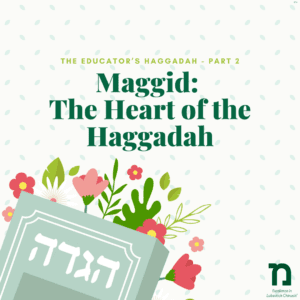By Chanah Rose
If the Chinuch emphasis of the Haggadah comes from the Posuk “v’higad’ta livincha bayom hahu – and you should tell your children on this day,” (Shemos 13:8) then Maggid, which shares the root of “telling”, is the heart of the Haggadah.
Once the stage has been set (see more in Part 1 of this series), Maggid is where we teach, retell, and convey everything we want our children to know about their Jewish identity. The bulk of the actual Haggadah, Maggid is paradigmatic for how Chinuch unfolds.
Inclusion and Scaffolding
Before we begin, we make a bold statement – Chinuch is for everyone. All are invited to Maggid.
In the opening passage of “Hei Lachma Anya,” we open our metaphorical doors wide to invite anyone who may be hungry to our Pesach Seder. Similarly, we invite all who are thirsty for knowledge to come and learn.
The prerequisite for teaching is inclusion, and it was identified as such in the Haggadah, before the term inclusion was ever coined. What’s more, we say this passage in Aramaic, the local language at that time, to ensure the invitation reaches the ears of all who need it.
Similarly, we need to set a baseline that begins at each child’s level. While our goal is ultimately to help each one climb the ladder of learning, we need to begin where they’re at, carefully scaffolding every step of the way to ensure that every child is still with us.
Questions
Then, the dramatic beginning of Maggid, as each child steps up for their turn to ask Mah Nishtana, the four questions. Questions come first, because they drive the learning that follows.
We don’t say, as a teacher often does at a lesson’s conclusion, “Does anyone have any questions?” Instead we open up with, “Surely you have questions, what are they? What interests you about this topic? What do you want to know?” And follow up with, “Here are some more questions you might want to ask. Do you wonder about these things? So do I!”
Questions are a ladder that we climb to reach understanding. In the words of the ספר פנים יפות על התורה מבעל הפלאה – פרשת כי תבא:
“ואי אפשר לעלות במעלות התורה הנשגבה עד שנולדה לו ספיקות וקושיות.”
“It is impossible to ascend the steps of the lofty Torah until one has generated doubts and questions.”
As a person rests on one rung of the ladder, they come to see a new way of looking at things, which begs another question, and pushes a person to reach for the next rung.
If we were satisfied, we would never progress. A question mark at the end of a sentence instead of period, turns it from a place to rest in complacency into a path for growth.
As phrased by Rabbi Chaim Miller in his commentary on the Haggadah (Toras Menachem Haggadah, commentary on Mah Nishtana, based on the Sichah of the night of Simchas Torah 5736), to answer the question of why we repeat Mah Nishtana the second night: “In Judaism, questions are as much a part of the text as the answers themselves, such that they must be repeatedly studied and emphasized.”
So let’s encourage questions. Even when we don’t know the answer, the questions themselves are a sign of life, of growth, and of learning.
Differentiating Instruction
Before we begin to teach, we need to know to whom we’re speaking. In the Haggadah, we are told, we are speaking to four different kinds of children. The Rebbe expands this to five (including the son who is not yet present), and these are the prototypes for the myriad children in our care, each of whom need to be educated a little bit differently.
The lessons from the passage of the Arba Banim are many, but here is one thought for each child (with links for further reading):
- חכם: A thinking mind needs to be utilized for לימוד התורה. The upper third of our class needs to be challenged with the intricacies of הלכה and the deeper meanings of our heritage, lest the חכם slip into the role of his neighbor, the רשע, who takes his questions and potential elsewhere. (Read more here: The Wise Son)
- רשע: His fundamental error is “excluding himself from the כלל;” he feels alienated and does not belong. As educators, we must channel his passions and questions to the services of ‘ה. By showing him how to find personal relevance and find his own place at the סדר table, this child can be transformed.(Read more here: The Lonely Son)
- תם: The middle third of our class benefits from engaging lessons, painted in dramatic color, about the “strong hand” ‘ה displayed and the miracles that He has done for us. Throughout our teaching, using stories, multiple learning styles, and engagement techniques will draw this child in and set them up on a path of lifelong learning and inspiration.(Read more here: The Wow Factor)
- שאינו יודע לשאול: The students who neither challenge nor participate, may seem beyond our reach. However, the הגדה obligates us to take the initiative, by creating a learning environment that piques even their interest, and by using the variety of professional methods within our reach to get to the root cause of their apparent apathy. (Read more here: Silent No More)
- The Fifth Son: The רבי’s message about the fifth son who doesn’t even attend the פסח סדר reminds us about the necessity of expanding the doors of our חינוך even wider, and ensuring that every Jewish child receives the education that they deserve.
Stories That Matter
Finally – the story we’ve been waiting for. When we tell the story of Yetzias Mitzrayim, we start at the very beginning, establishing our identity, telling the story of who we are. Taking nothing for granted, Maggid gives us a comprehensive narrative of what it means for Avraham Avinu to come from a family of idol worshippers and go on to beget the Jewish people – us.
Stories are key to Chinuch, because identity is key to Chinuch. Here are a few takeaways from this part of Maggid:
- When telling the story of our people, don’t underestimate the power and importance of giving a comprehensive history of who we are. Ensure children understand the chronology, the context, the cause and effect – not just isolated incidents or time periods, but the vast sweeping narrative that leads right up until this very moment.
- Tell personal stories, and encourage children to tap into their own. Psychologists have identified the difference between children who grow up with victim narratives vs. redemptive narratives. Children who grow up hearing stories of victimhood – hardship and bad luck, often grow up lacking resilience. Children who grow up hearing redemptive stories – things were hard and then they got better, this difficult thing happened but then Hashem helped, we struggled and overcame – these children have greater resilience, optimism, and can face what life brings.
All of Jewish history is a redemptive story, if we present it as such, and every Jewish family has its own story of triumph and salvation. On an individual level, we all do as well – a personal Yetzias Mitzrayim each and every day. - The Hayom Yom of 26 Menachem Av states: “Part of the Chassidishe Yetzias Mitzrayim… means telling Chassidishe stories, and listening and internalizing them in one’s innermost self….” This means that telling and listening to a Chassidishe story is one way to fulfill the Mitzva of Sipur Yetzias Mitzrayim!
The Rebbe instructed teachers on a number of occasions to make a habit of telling stories of Tzadikkim to their students. Rabbi Shimon Raichik a”h emphasized that we should also tell stories of Chassidim – including contemporary Chassidim that children can relate to. The lessons of greatness, miracles, self-sacrifice and making the right choice that are contained in such stories are as powerful as the lessons of Yetzias Mitzrayim, because they show how an ordinary person can rise above – and you can, too!
Once we have told the story, it’s time to bring it down – into our kishkas. Through food, song, and the five senses, we teach through experience, until the lessons learned are truly one with every part of us. For more Chinuch lessons from the final steps of the Pesach Seder, check back with us next week.






